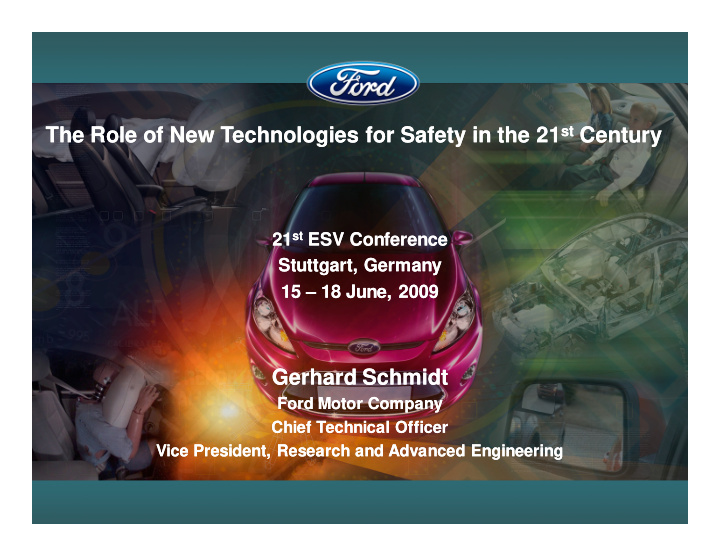



The Role of New Technologies for Safety in the 21 st Century The Role of New Technologies for Safety in the 21 st Century 21 st ESV Conference 21 st ESV Conference Stuttgart, Germany Stuttgart, Germany 15 – 18 June, 2009 15 – 18 June, 2009 Gerhard Schmidt Gerhard Schmidt Ford Motor Company Ford Motor Company Chief Technical Officer Chief Technical Officer Vice President, Research and Advanced Engineering Vice President, Research and Advanced Engineering
Outline • State of Safety • Sustainability and Safety • Safety Technologies • Shared Responsibilities
Source: World Health Organization, 2006 Top 10 Causes of Death & Disability in the World (2004) Road Accident Fatalities are a significant cause….. Lower respiratory infections Diarrhoeal diseases Unipolar depressive disorders Ischemic heart disease HIV/AIDS Cerebrovascular disease Prematurity and low birth weight Birth asphyxia and birth trauma 9 Road traffic accidents Neonatal infections & other
Source: World Health Organization, 2006 Top 10 Causes of Death & Disability in the World (2030) And will be more important in the future HIV/AIDS Unipolar depressive disorders Ischemic heart disease 4 Road traffic accidents Perinatal conditions Cerebrovascular disease COPD Lower respiratory infections Hearing loss Cataracts
Estimated Worldwide 2004/5 Traffic Fatalities Total: 1.3 Million Fatalities in 2004 Other Light Truck Car Motorcycle Bicycle Pedestrian US UK Japan India 0% 20% 40% 60% 80% 100% Percentage of Fatalities Vehicle safety technologies may need to vary by region Sources: - WHO, World Report on Road Traffic Injury Prevention, 2004 - International Road Traffic and Accident Database (IRTAD - OEC/ITF), 2008
Fuel Economy • Fleet shift to smaller vehicles will increase compatibility challenges • Alignment of structures per Voluntary Agreement will help increase compatibility in North America • Structural enhancements (e.g., adaptive structures) can help reduce the impact of downsizing and weight reduction
Effect of Changing Vehicle Mix on Fatality Rates Drivers killed / 1000 crash events* Vehicle-to-Vehicle Accidents 1.6 1.6 0.8 0.8 0.6 0.6 0.7 0.7 1.2 1.3 1.6 0.3 0.9 0.9 Single Vehicle 5.8 2.0 0.3 0.9 1.2 3.7 2.1 0.5 10.6 Changing the fleet mix increases the likelihood of 10.6 incompatible vehicle interactions * All crash types included in analysis Source: UMTRI
Vehicle Compatibility 3.0 Geometry Mass & Size Fatality Risks 2.0 1.0 0.0 600 1400 2200 Mass (kg) 50 3000 Mini Car Peak Acceleration (g) Mass & Size B Car 40 C/CD Car Mass (kg) 2000 1000 25 Crush Space 15 0 400 600 800 0 2 4 Max Crush (mm) Wheelbase (m) Sources: Evans, AJPH, 2001 & Evans, SAE, 2004
Small Vehicle Safety Challenges • Smaller vehicles, in general: are lighter and have less crush space have lower structural height experience higher accelerations than larger vehicles in multi-vehicle accidents • Therefore, the challenge for the safety community is to: continuously improve safety by democratization of safety technologies (e.g., airbags, ESC, etc) make newer technologies affordable for small vehicles
Safety Technology Trends Levels of autonomous safety features for driver assistance/accident avoidance and crash protection will increase due to: Increasing computing power Faster algorithms Advanced sensor capabilities Lower sensing costs Advanced electrical chassis systems
Safety Technologies Outlook Safety potential Passive safety 100% preactivated restraints Active safety compatibility adaptive restraints active accident avoidance safety pedals side impact protection V2V & V2I side airbag active driver assist. advanced seat belts collision mitigation front bag active steer head restraints lane detection crumple zone active body control brake assist ACC safety belts ESP safety cell traction control ABS ... 1960 1970 1980 1990 2000 ? ?
Ford Safety Technology Implementation – 2010 Taurus SecuriCode TM Keyless Entry Keypad Power Sunshade R R Ford SYNC Ford SYNC Rain Sensing Wipers Cross MyKey TM MyKey TM Traffic Alert Multi-Contour Seats Multi-Contour Seats With Active Motion TM With Active Motion TM Adaptive Cruise Control Blind Spot R ) Collision Warning Information(BLIS Auto High Beams With Brake Support
Shared Responsibilities Infrastructure • Design • V2I Integration • Construction/Maintenance • Rescue chain Driver OEM • Safety belt use • V2V communications • Blood alcohol limits • Pre-crash technology • Speed limits • Adv. crash technology • Driver education • Post-crash technology Government Consumer • Global regulations • Relevant tests • Partnership with industry • Solicit input from OEMs • Seatbelt use laws before new testing protocols • Litigation Reform • Communication Breakthroughs in safety will occur when all entities work together.
Outlook • Vehicle safety technologies will make a significant contribution to the improvement of road safety • Technologies must address customer needs and be adapted to specific national situations • Shared responsibilities exist for all stakeholders
Recommend
More recommend